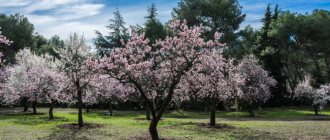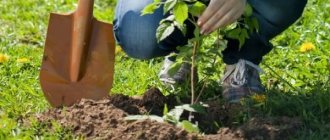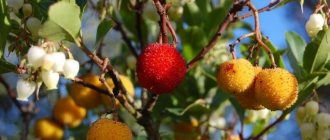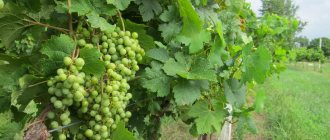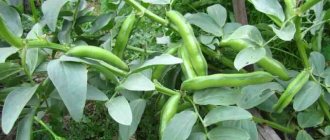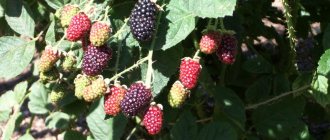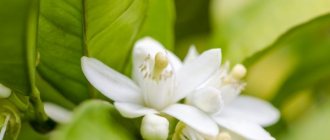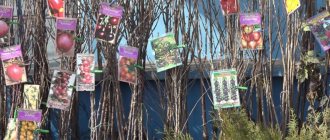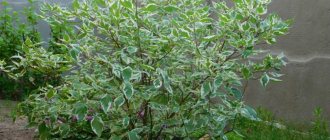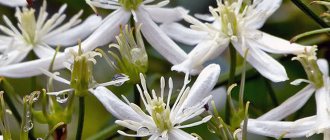Description and characteristics of raspberry tree
The raspberry tree is a new generation of crops that have a powerful standard-type stem. The first variety that belonged to this variety was Glen Ampl. He was bred in Scotland. From 1 bush it was possible to get 3.5 kg of beautiful fruits.
Today there are many remontant crops that produce crops from the beginning of summer until the coldest weather. Among the domestic varieties of such raspberries, the most popular varieties are Krepysh and Tarusa. They have a similar description.
The raspberry tree is a strong and powerful crop
For reference! This culture can reproduce in different ways. To do this, you should use shoots or cuttings. The procedure can also be carried out by dividing the bush.
Fertilizers for feeding standard raspberries
At the beginning of spring, it is advisable to feed the “raspberry tree” with a solution of urea diluted with 50 grams of granules per 10 liters of water per 3 bushes. Organic feeding with infusion of bird droppings or mullein is also possible. Before flowering - in early May, it is good to feed with an aqueous solution of nitroammophoska or nutrivant drip (2 tablespoons per 10 liters of water for three bushes).
Good results are shown by monthly foliar feeding of foliage from the beginning of budding with solutions of multimicroelements: “Ryazanochka for berry crops” (1 teaspoon of product per 10 liters of water) or “Nutrivant plus fruit” (2 tablespoons of product per 10 liters of water). There is a very useful anti-stress drug “Aminokat 30%”, which is used for spraying standard raspberries under unfavorable weather conditions: late frosts, heat and sunburn, and mechanical damage to branches.
Main varieties
Currently, a large number of varieties of raspberry bushes and trees are known. They have characteristic features. Popular cultures include Fairy Tale, Gold, Bogatyr and many others.
Tarusa
This plant may be called tree raspberry. It is a standard crop that resembles a straight tree with a thick trunk.
The plant can be grown without trellises or stakes. At the same time, it will look quite attractive. Standard raspberries can grow to a height of 1.5-2 m.
Sturdy
The culture can reach a height of 1.5 m. It is characterized by small fruits of a dark crimson color. The plant gives a bountiful harvest. At the same time, it is distinguished by its unpretentiousness to growing conditions.
Important! The variety is characterized by a well-developed root system. Thanks to this, it is possible to productively propagate the crop.
Fairy tale
The plant is in many ways reminiscent of the Tarusa raspberry. The variety does not contain thorns and has fairly large fruits that weigh up to 15 g. The berries have excellent taste. In favorable conditions, the variety produces an excellent harvest. At the same time, resistance to frost is reduced, so the plant needs to be covered for the winter.
Raspberry tree propagation techniques
Raspberry trees can be propagated at home. For this, two main methods are used - cuttings and root shoots.
Both options relate to the root system of a standard crop and imply a similar process:
- To grow seedlings, it is necessary to prepare a substrate from an equal mixture of sand and peat.
- Cuttings or root shoots are placed in the prepared composition and sent in a container to a warm place.
- Seedlings are ready for planting only after the formation of the first leaves after separation from the mother plant.
The main difference in the procedure is that the meaning of cutting is a part of the root system with a bud, which is dug up and carefully separated from the main plant, and the root shoot is such a bud that has already developed and a formed shoot.
By the next season, plants can be planted in open ground and new trees can be expected to grow.
Advantages and disadvantages
The key advantages of culture include the following:
- ease of care;
- there is no risk of raspberry thickening - this is due to the minimum of root growth;
- high yield - achieved due to the abundance of side shoots;
- large fruits that have a long shelf life;
- strong trunks - thanks to this they do not break from the wind or under the weight of fruits;
- cold resistance - some varieties produce crops until late autumn;
- ease of harvesting - this is due to the sufficient height of the bushes.
The key disadvantage of the culture is the mediocre taste and aroma of the berries when compared with ordinary raspberry varieties. Moreover, these parameters largely depend on the composition of the soil, the amount of sun, and the irrigation regime.
The plant is characterized by large fruits
Formation, pruning and shelter for the winter
In order for standard shoots to become real trees, they need to be formed correctly. Since each shoot takes up a lot of space, more than 6-7 of them are not left in the bush. The weakest and damaged ones are cut out. This operation is best carried out together with the removal of fruit-bearing trunks after harvesting. Formation of standard raspberries.
- At the beginning of June, and in the south and at the end of May, the main shoot is pinched, cutting off 5 cm of the top. By this time it should have grown to 1.2 m. You cannot be late with pinching, otherwise the side branches that will grow on the bush after it will not have time to ripen before winter and will freeze.
- In the spring of next year, pinch out all the side shoots so that third-order branches grow.
In remontant varieties, it is possible to perform only one pinching, so only annual shoots are left.
This method of formation is suitable for any raspberry, but non-standard varieties will have to be tied up very carefully due to the heavy load of the harvest.
Non-remontant standard varieties, due to their poor frost resistance, need shelter for the winter. It will not be possible to bend such a bush to the ground in one go - it will simply break. This is done gradually over several days, bending lower and lower. Bushes prepared for wintering are covered with lutrasil.
Remontant varieties require annual pruning at the root for the winter. It is not advisable to leave annual shoots to harvest from them in the second year in the summer - the autumn harvest will ripen later and will be much smaller than expected. It should be done as late as possible, since the outflow of plastic substances from the stems to the roots continues until frost.
Proper crop care
Planting, caring for and propagating raspberry trees have certain features. They should definitely be followed to obtain a bountiful harvest.
Watering and fertilizing
To grow a strong and healthy plant, it needs to be watered in a timely manner. It is important to ensure that the soil around the bush does not dry out. The root system is located quite close to the surface of the earth, so the plant tolerates moisture deficiency with great difficulty.
To cope with the problem, soil mulching is used. Mulch should be placed so that it fully retains moisture and does not interfere with the development of replacement shoots.
Loosening the soil is carried out shallowly to avoid damage to surface roots. Regular weed removal is important. But when the bed is fully mulched, it practically does not grow.
Timely application of fertilizers is of great importance. To provide the bushes with potassium, they should be fertilized with wood ash. For 1 plant you need to use 450 g of the product. It is best to apply the composition in the spring.
Nitrogen products should be used at the stage of bud break. An excellent solution during this period would be a herbal infusion of nettles.
Important! To increase yield parameters, you can use foliar feeding. For this, products such as Ryazanochka or Sudarochka are suitable.
Trimming
Proper care and cultivation of a raspberry tree is impossible without the formation of a crown. The plant should be pruned in the spring immediately after planting. In this case, you should leave the main trunk and 5 branches to get the shape of a tree.
During the period of crop development, shoots need to be trimmed by 10-15 cm. In May, after planting, seedlings should be pinched to ensure the formation of new shoots.
How to care for a tree
Beds with bushes should be weeded and cultivated using a cultivator. Experienced gardeners recommend mulching the soil with peat and sawdust. Thus, the substrate becomes more fertile, weeds grow less, and moisture in the soil is retained longer.
Popular: Asparagus bushes (sprars) in the interior of a house or garden
Weeding is necessary so that the substrate does not overheat when the weed roots intertwine. The bed must be loosened so that air can freely penetrate to the roots of the raspberry tree.
If there are severe frosts in the climate zone where the bush grows, then it is recommended to prepare the raspberry tree for winter. To do this, the bushes are bent to the ground and covered with agrofibre. If you don’t do this, the branches will become brittle in the spring. It is possible that they will freeze completely in winter.
Protection from pests and diseases
Raspberries often face pest attacks. The plant may suffer from attacks by the raspberry beetle. Adults lead to the destruction of above-ground fragments. In this case, the larvae eat raspberry fruits.
To cope with beetles, in the spring, when loosening the soil, you need to carefully inspect it. Treating the soil with Karbofos and hilling the plant is of no small importance.
The plant may also suffer from moth attacks. It attacks old branches and dry leaves. To prevent attacks by parasites, damaged fragments of the crop should be removed in time. Preventive spraying of raspberries before buds appear is of no small importance. Otherwise, the moth will lead to their defeat.
Another pest of raspberries is the weevil. It provokes damage to the stalks and lays its larvae in the buds. To cope with parasites, you should use an infusion of red pepper or tansy.
Attention! You should not plant raspberries next to strawberry beds - the plants can “exchange” parasites and diseases.
Sometimes the crop is affected by the raspberry fly. Its larvae cause damage to the foliage of the crop. To cope with parasites, you need to remove clutches of eggs from the upper parts of seedlings. After this, the plant is sprayed with a solution of potassium permanganate.
In addition to pests, raspberries can suffer from diseases. In this case, the foliage becomes covered with bumps or spots. To cope with the problem, you need to remove the damaged fragments and treat the raspberries with Hom or Bordeaux mixture.
Landing
Let's get acquainted with the features of rooting a raspberry tree.
Selecting a location
The plant should be planted in a sunny area: in the shade it is unlikely to achieve good harvests. The soil must be nutritious and loose: raspberries require high permeability of the substrate.
It is important that the site is not low-lying: places where groundwater accumulates are categorically not suitable for a raspberry tree. In addition, care should be taken to protect the area from the north wind: although the tree is stable, drafts do not have a very favorable effect on it.
To reduce the acidity of the soil, it is recommended to add lime before planting: an acidified substrate is not suitable for this plant. If the bed is located in a low area, you will have to form a mound to protect the roots from rotting.
Neighbours
Make sure that the following crops do not grow near raspberries:
Close proximity to the listed plant species can lead to infection with common infections and pests.
Site preparation
In order for the soil to meet the requirements regarding the level of fertility, it must be fertilized before planting. You should enter:
Fertilizers must be mixed with the soil and given time to absorb.
Deadlines
Planting a raspberry tree can be done in the fall: choose a period when the summer heat has already subsided, but the first frost is still far away. But it is optimal to plant in the spring: in this case, choose March or April.
Planting Tips
- When planting several raspberry trees, try to place them away from each other. This measure is connected with the need to relieve plants from thickening and shading. The minimum distance is half a meter, but ideally you need to maintain a greater distance. The distance between rows is 2.-2.5 meters.
- When planting several plants at the same time, it is more logical to dig not individual holes, but a common trench.
- The depth of the hole and trench should be 30 cm - the raspberry root system is superficial and does not go deep.
- Place organic matter at the bottom of the depressions - humus, compost or peat. Sprinkle the layers with soil.
- When planting, it is very important to avoid deepening the root collar of the seedling. It is permissible to dig it in only 2-3 cm, no more: otherwise it is likely to rot.
- After planting, the young plant is pruned. Only 30 cm of shoots are left.
Let's find out how to care for a raspberry tree to obtain high yields of delicious berries.
Mulching
The procedure in this case is important, since there is a need to protect the raspberry roots located close to the surface from drying out.
Loosening and weeding are also difficult for this reason, so mulching remains the only way to ensure long-term hydration of the roots, soil permeability and protection from weeds.
Top dressing
In order for raspberries to produce impressive harvests, you cannot do without additional nutrition. In the spring, it is recommended to add nitrogen-containing organic matter: manure or chicken droppings. Then you should switch to fertilizing containing potassium and phosphorus.
Prevention
The raspberry tree has good resistance, however, sometimes as a result of waterlogging or thickening, the fungus still attacks the plant.
To avoid problems, it is necessary to take preventive measures. It is optimal to spray the plant with Bordeaux mixture: this drug is safe for the crop, but it poses a strong threat to the fungus.
Watering
Standard raspberries are quite sensitive to soil moisture. The plant experiences a special need for water in two periods:
- when the ovaries form;
- the berries are ripe.
At this time, you should water the raspberries once a week, in other periods - once every 10-14 days.
But do not overdo it with watering, since waterlogging of the soil leads to rotting of the plant’s roots.
Trimming
To give the plant a tree-like shape, regular formative pruning is necessary. The procedure is carried out in two steps:
- In the first spring, the shoots are shortened by 5-10 cm to enable the plant to form a large number of fruitful branches.
- In the second year in the spring, these same branches are shortened by 15 cm to form third-order shoots.
In addition, no one has canceled the sanitary stage: in spring and autumn, remove old, dried out, diseased shoots. In the fall, you should also get rid of shoots that bear fruit this season. The raspberry tree has a two-year development cycle, so next year only new branches will bear fruit.
Topping
A raspberry tree can bear fruit not once a year, but twice: but for this it is necessary to pinch the shoots correctly. The procedure is carried out in the fall, leaving sanitary pruning until the spring. Thus, the gardener has the opportunity to control the yield of the plant at his own discretion. Just don’t forget that two-phase fruiting significantly depletes raspberries.
Wintering
A raspberry tree without shelter will survive frosts, but not severe ones. If the region is cold, it is necessary to take care of protection. To do this, the raspberries are bent to the ground and covered with agrofibre on top.
Transfer
Ten years after rooting, the raspberry tree must be transplanted to another location. This measure is due to the fact that the soil in the old place is already fairly depleted, and the yield is reduced because of this. To restore the soil, it is recommended to plant green manure on the old site.
Harvesting
Fruit ripening begins in mid-July. However, the timing may vary depending on the region. The harvest must be harvested as it ripens. It is advisable to do this every 2 days. Because overripe berries have a shorter shelf life and may become wrinkled during transportation.
Important! Do not collect fruits in rainy weather or after dew has fallen. Such raspberries will not be stored for long.
For transportation, it is recommended to pick the berries with the stalk. At the same time, they do not need to be poured from one container to another.
With adequate care, raspberries produce a bountiful harvest.
Tree raspberries are a popular garden crop. It produces a bountiful harvest and is easy to care for. However, for better fruiting, it is worth watering, feeding and pruning the raspberry tree on time.
Description of the plant
The main advantage of a raspberry tree is that it does not need additional support.
The branches of a standard crop are capable of bending under the mass of fruits, but they do not reach the ground due to the shortening of the internodes.
There is no need to tie up such raspberries, the only thing is that the perennial may need additional support at a young age in case of strong gusts of wind.
Caring for such a shrub is the same as for the bush form of raspberries.
Benefits of growing a raspberry tree
Selected varieties of standard raspberries have significant advantages over other raspberry varieties:
- Strength of shoots - thick branches of the bush hold the crown well, do not require the installation of supports, a plurality of side branches and shoots gives a high yield of juicy, aromatic and healthy berries. The strong branches of the bush support the weight of the berries and do not fall under the weight of the harvest or when there is a gust of wind in bad weather.
- Frost resistance: the plant is not afraid of cold weather, can withstand low temperatures, strong winds, bears fruit until frost, in some cases it is possible to cover the shoots with agrofibre for the winter.
- Unpretentiousness, ease of care: straight, tall bushes grow up to two meters in height and do not require special conditions when planting or growing.
Growing
Photo of planting scheme:
The raspberry tree is unpretentious to grow and care for. By following simple rules, you can easily achieve high yields.
Landing
Raspberries are a light-loving crop, therefore, well-lit places protected from strong winds are chosen for planting.
It is recommended to plant tree raspberries in the spring. To do this, a month before planting, prepare planting holes or trenches. The depth of the holes should be at least 50 cm, the diameter should be the same. The trenches are made 100x100 in size. The distance between plants when planting in holes is left at least 1 m, and in trenches - at least 50 cm. The distance between rows should be at least 2.5 m.
When planting, humus and wood ash are used as fertilizer in equal quantities. The holes and trenches are filled halfway with fertile soil mixed with fertilizers, the seedlings are placed with the roots straightened, and covered with the remaining soil. Compact and water with water, in the amount of 5-10 liters per bush. The spaces around the plants are mulched with humus or peat.
When and how to plant Tarusa raspberries
Planting time depends on the region, but the most optimal period is most often autumn (mid-September - late November) and spring (early March - late April).
The landing algorithm looks like this:
- Dig holes at a distance of half a meter from each other.
- Add fertilizer.
- Place the seedling.
- Fill the hole with soil and compact it.
- Trim the shoots, leaving a maximum of 25-30 centimeters.
- Mulch the soil.
- Water the seedlings (one bush requires approximately 5 liters).
- For the first couple of days, isolate the raspberries from direct sun.
Propagation of Canadian raspberries
Standard raspberries reproduce by root shoots.
- Young replacement shoots are used for propagation.
- When pruning the bush, no more than three additional shoots are left, which grow in a cluster in the root zone.
- Layers are transplanted in September. First, the seedling is pruned at a level of 40 cm above the ground.
- Then the seedling is planted without deepening, watered, and mulched with straw. No additional care is provided.
Useful properties of raspberry tree
Raspberries have a set of useful elements: glucose, sucrose, fructose; malic, citric, salicylic acids; vitamins A, B, C; contain zinc, copper, iron, calcium, minerals and salts. The berries of yellow varieties have a high carotene content.
Together with medications, raspberries are useful for various diseases:
- Colds, flu, acute respiratory viral infections (in the form of a drink, it is used as an excellent diaphoretic and antipyretic);
- Relieves severe cough;
- It is recommended to take it for gastritis, atherosclerosis, scurvy (due to the high content of vitamin C), anemia (replenishment of iron deficiency in the body).
